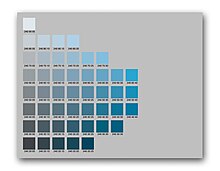RAL design system
The RAL design system (product name: RAL DESIGN ) is a color system that has been published by RAL non-profit GmbH since 1993 . In contrast to the RAL Classic and RAL Effect color fans , which are pure color collections, the RAL design system has a systematic approach. The system's color fans available on the market contain 1625 colors .
construction
In the first version from 1993, RAL represented the CIELab color space for the light type D65 and the observer angle 10 ° (according to CIE 1976) in the form of the polar coordinates LCh (lightness / brightness - chroma / chroma - hue / hue). The hues (Hue, h) form a color wheel in which red corresponds to 360 °. Yellow (90 °), green (180 °) and blue (270 °) follow in a counterclockwise direction. The chroma corresponds to the chromacity C *. The higher the specified value, the purer the color. The achromatic axis corresponds to Hue = 0 °, C = 0 and the brightness L * (0 = black, 100 = white, were realized between 20 and 92).
A RAL design color code is structured in the form HHH-LL-CC, which makes it easy to understand as hue - brightness - chroma.
The RAL design colors in the first version conceived by Ludwig Gall from 1993 represented systematically graded CIELab color examples. It was possible to specify intermediate colors that were not included in the color guide, since CIELab is a predictable, continuous color model.
In the meantime, RAL DESIGN has been changed several times, so that the CIEL * a * b * HLC designation is still used in the color names, but the colors themselves differ from the CIEL * a * b * coordinates (example: RAL 000 15 00 is specified with L * a * b * 12.97, 0.07. 0.31, but CIEL * a * b * -HLC 0 15 0 would correspond to Lab 15 0 0).
properties
The RAL design system was contrary to visually uniform color systems such as the Natural Color System (NCS) or the Munsell color system as colorimetric designed equidistant. The CIELab color space is mainly tapped in steps of 10 in Hue, Lightness and Chroma. However, at Hue = 75, 85, 95 intermediate levels were added. On many pages there are further (5) intermediate levels in C. In dark color areas, colors contained in the chosen system have been omitted since 2007, which leads to gaps in the CIELab color space.


